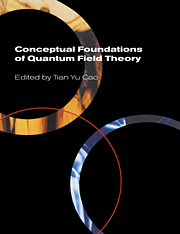Book contents
- Frontmatter
- Contents
- List of contributors
- Preface
- Photographs of the conference
- Introduction: Conceptual issues in quantum field theory
- Part One Philosophers' interest in quantum field theory
- Part Two Three approaches to the foundations of quantum field theory
- 3 The usefulness of a general theory of quantized fields
- 4 Effective field theory in condensed matter physics
- 5 The triumph and limitations of quantum field theory
- 6 Comments
- Part Three
- Part Four Mathematics, statistics and quantum field theory
- Part Five Quantum field theory and space-time
- Part Six
- Part Seven Renormalization group
- Part Eight Non-Abelian gauge theory
- Part Nine The ontology of particles or fields
- Part Ten
- Name index
- Subject index
5 - The triumph and limitations of quantum field theory
Published online by Cambridge University Press: 22 September 2009
- Frontmatter
- Contents
- List of contributors
- Preface
- Photographs of the conference
- Introduction: Conceptual issues in quantum field theory
- Part One Philosophers' interest in quantum field theory
- Part Two Three approaches to the foundations of quantum field theory
- 3 The usefulness of a general theory of quantized fields
- 4 Effective field theory in condensed matter physics
- 5 The triumph and limitations of quantum field theory
- 6 Comments
- Part Three
- Part Four Mathematics, statistics and quantum field theory
- Part Five Quantum field theory and space-time
- Part Six
- Part Seven Renormalization group
- Part Eight Non-Abelian gauge theory
- Part Nine The ontology of particles or fields
- Part Ten
- Name index
- Subject index
Summary
The triumph of quantum field theory
Although the title of this session is ‘The foundations of quantum field theory’, I shall talk, not of the foundations of quantum field theory (QFT), but of its triumphs and limitations. I am not sure it is necessary to formulate the foundations of QFT, or even to define precisely what it is. QFT is what quantum field theorists do. For a practising high energy physicist, nature is a surer guide as to what quantum field theory is as well to what might supersede it, than is the consistency of its axioms.
Quantum field theory is today at a pinnacle of success. It provides the framework for the standard model, a theory of all the observed forces of nature. This theory describes the forces of electromagnetism, the weak interaction responsible for radioactivity, and the strong nuclear force that governs the structure of nuclei, as consequences of local (gauge) symmetries. These forces act on the fundamental constituents of matter, which have been identified as pointlike quarks and leptons. The theory agrees astonishingly well with experiment to an accuracy of 10−6–10−10 for electrodynamics, of 10−1–10−4 for the weak interactions and of 1–10−2 for the strong interactions. It has been tested down to distances of 10−18 cm in some cases. We can see no reason why QFT should not be adequate down to distances of order the Planck length of 10−33 cm where gravity becomes important.
- Type
- Chapter
- Information
- Conceptual Foundations of Quantum Field Theory , pp. 56 - 67Publisher: Cambridge University PressPrint publication year: 1999
- 3
- Cited by



